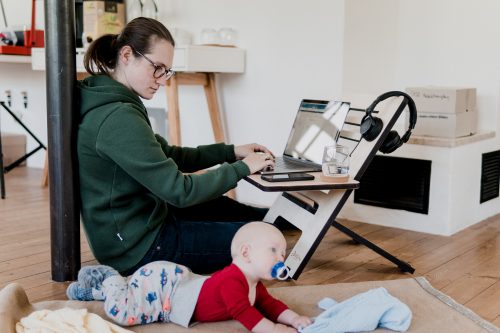As 2020 inches toward the finish line, many pandemic-induced modifications to everyday life will carry over into the new year. One change, in particular, stands out as a potential long-term implementation—working from home. Before the global pandemic, at-home work was a scarce, inaccessible option. However, mandatory stay-in-place orders forced a shift from in-person to remote workspaces, creating a new, invaluable medium for workaholics and homebodies alike.

With this workplace transformation came a storm of complications—among them the inability to strictly regulate work attire. Employees are swapping uncomfortable slacks and pencil skirts for athleisure and matching pajama sets, mirroring their current work environment. Although strict, professional dress codes were on the decline before 2020, remote work has caused a landslide of new, more lax guidelines. The question is: will these relaxed attire specifications last?
Benefits of a dress code
Whether you’re an essential worker sporting wholesale CornerStone apparel or a financier dressed in head-to-toe business professional, there are undeniable benefits of workplace dress codes. While the jury is still out on whether business casual and beyond produces productivity, there are undeniable benefits to a stringent workplace dress code. Although the expression dress-to-impress may be a cliche, there’s a reason for its popularity. When you dress professionally, you give off an excellent first impression to employers, positively represent your company, and improve your reputation and credibility as a working professional.
Dress-code free benefits
Although opponents of casual workwear maintain relaxed attire equates to a lack-luster work environment, proponents argue the opposite. According to casual-dress advocates, informal guidelines regarding workplace attire set employees up for a more positive, productive work experience.
Comfortable people perform better—at least that’s what billionaires like Mark Zuckerberg assert. Zuckerberg sports jeans and a hoodie daily, maximizing his time and saving unnecessary money on professional clothing. Surprisingly, employers offer a more flexible, authentic, productive workspace by discarding strict regulations and replacing them with casual codes of conduct.
Remote work and dress code
Although casual dress codes were becoming increasingly popular independent of a global pandemic, remote work has taken casual Fridays up a notch. Although some employers still require business-casual standards—implemented via zoom calls—others have given up on policing virtual workspace attire. The latter group argues there are more pressing fires to dowse than which pair of raggedy pajamas their stressed-out employees have decided to dawn.
However, individuals who prioritize professional attire—whether by choice or mandate—report the ability to draw a distinct line between home and work more efficiently. Adjusting to virtual workspaces has been tumultuous at worst and a tedious adjustment at best. Between revamping time management strategies, distraction elimination, and inconsistent, faulty internet connections, remote work comes with a long list of technical—and personal— difficulties. Putting on a fresh pair of pants may not eradicate a pandemic-sized list of anxieties, but it may be just what you need to kick-start your workday.
Wrap up
As more companies continue to switch from in-person to virtual workspaces, employees will likely have a choice in what attire they choose day-to-day. Personal preference may come into play more frequently as employers shift their focus from policing workwear to employee connectivity and engagement in the Digital Age.
Interesting Related Article: “How to Keep Remote Workers Engaged“

